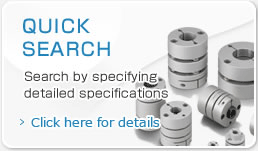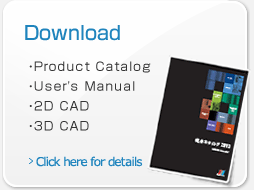The Electromagnetic Clutch / Electromagnetic Brake Overview
The Role of the Electromagnetic Clutch and the Electromagnetic Brake
To Begin With, what are a Clutch and a Brake?
The clutch and brake are built into the depth of the product. They serve an important role in the control of movement (motion control).
Currently Electromagnetic Clutches and Electromagnetic Brakes are the Mainstream
Many brakes and clutches used nowadays are electromagnetic and utilize the magnetic force of electromagnets. An electromagnet is an iron core material with wire coiled around it that generates a magnetic field. When electricity is run through the coil, a magnetic field is generated. When the electricity is shut off, the magnetic field dissipates. Clutches and brakes that use this phenomenon are referred to as electromagnetic clutches and electromagnetic brakes.
Electromagnetic clutches and electromagnetic brake each have different roles.
Below is the explanation of the basic role and mechanism of the brake and clutch.
The Role of the Electromagnetic Clutch
The electromagnetic clutch bears the joint role of transmitting and intercepting the power to the driven side from another section within the machine, such as the concentric axial motor.
When the clutch is turned off the axis becomes fixed and it won’t spin. When the clutch is turned on the axis will spin. This on-off ability of the clutch transmits power to the driven side.
The Role of Electromagnetic Brake
The electromagnetic brake is responsible for the deceleration and stopping of a moving object as well as putting it in a stationary state. It has the role of decreasing speed and stopping the power generated by the motor.
When the brake is off the axis of the motor, the motor will spin and when it is on the axis of the motor, the motor will stop.
The Two Methods of Operation
There are 2 types of operation methods: “The Excitation type” and the “Non- Excitation type”
The excitation type involves a clutch and brake that operates by electrification of the coil. The non-excitation type is a brake that operates via a spring triggered due to the power failure of the electrification of the coil. There is currently a trend of the excitation type being used industrially but there is also a big advantage in using the non-excitation type, as it is useful for stopping the motor in emergency situations.
Electromagnetic clutches and Electromagnetic Brakes Used in Various machines
Electromagnetic clutches and electromagnetic brakes are used in many essential industrial machines in various factories and workshops. There are numerous fields and systems in which they are used such as science, the environment, tanks, boilers, motors, plastic machines, transportation and iron manufacture.
They are also used in familiar places like OA equipment such as printers, fax machines, copy machines, automobiles, medical equipment and lawn mowers. For example, they are used in paper ejection systems, paper conveyers, positioning of paper as well as the drive and stop of printers.
Micro-electromagnetic clutches are used in equipment that is not too large, such as OA equipment. There is also some equipment that utilizes multiple electromagnetic clutches.
The Operating Principle of the Electromagnetic Brake and Clutch
Electromagnetic clutches and electromagnetic brakes each have characteristics involved in the operating principle.
The Operation of the Electromagnetic Clutch
Transmission and Interception
Transmission and interception are the basic operation function of the clutch.
Operating the motor while spinning requires the transmission and interception of power. When switching between a manual feed and an automatic feed, it is also used as a separator of two power sources. As well, by using multiple clutches, multiple loads can be controlled from one power source independently. This operation function is used by copier machines.
Variable Speed
With a clutch, it is possible to stage shift variables while spinning. Thus one can combine machine elements and gears etc. using an optional multiple clutch with a variable speed.
These functions are used in agricultural machinery.
Normal Rotation and Reverse Rotation
By combining the clutch and gear systems and by moving the clutch alternately, the load from the motor can be translated into the normal rotation as well as reverse rotation in the opposite direction at the same time.
Power can also be reciprocated into linear motion.
This function is used in packing machinery.
The Operation of the Electromagnetic Brake
Braking
Braking is the basic operation of the brake.
By stopping the inertial rotation of the machine quickly, it is used in the repetitive situation of starting up and stopping. Spring powered brakes that brake at all time「Non Excitation types」 operate as emergency braking systems.
This operation is used in inverted control systems on conveyor belts in wood working machinery, as well as deceleration, and stopping golf carts.
Retention
This function preserves a certain position after stopping the load.
This operation is used when mechanically stopping robotic machines and in preventing the falling of robotic arms. It is also used to maintain the position of medical equipment such as beds and cameras.
In recent years, due to the spread of the Servomotor, in which the drive and stop of the load are conducted by the motor, there has been an increase in non-excitation type brakes used for fall prevention of robotic arms that have been mechanically stopped.
The Operation of Electromagnetic clutches and Electromagnetic Brakes
Positioning and Indexing
Using brakes and clutches, you can detect the position and maintain stopping accuracy with brake positioning and rotational motion indexing.
Positioning and indexing are used for position stopping in the back gauge of cutting machines, for feeding packaging materials, and position stopping in filing and packaging machines.
High-Frequency Operation
As a result of using intermittent operation functions repeatedly, drive and stopping functions in motors have some limits, however, by using a clutch/brake system, tens to hundreds of drives and stops per minute become possible.
This function is used in material feeding, stopping and driving of cutters, and in the stopping of plywood machinery. They can also be used in sheet feeding and stopping, as well as position stopping for bag making machines.
Inching
In die matching in forging machines, by operating the clutch and brake alternately, it is possible to fine feed intermittently.
This is used in inching for die matching in Sintering presses as well as the inching required for cutting machine blade alignment.
 日本語
日本語 English
English Deutsch
Deutsch 中文
中文 한국어
한국어






